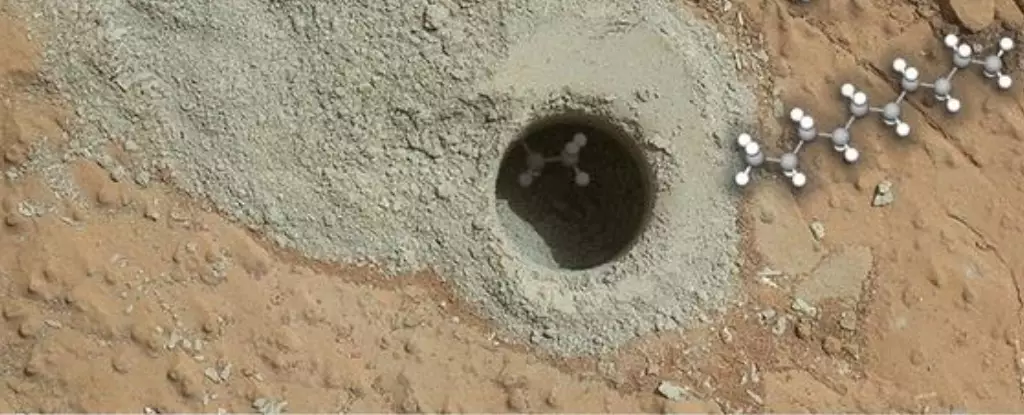Recent discoveries from NASA’s Curiosity rover have unveiled a groundbreaking truth about Mars – the detection of carbon chains potentially hidden in an ancient lakebed. This revelation sheds light on the history of organic compounds on the Martian surface, propelling forward our quest to understand whether life once flourished in a world now dominated by barren landscapes. The analysis, spearheaded by Caroline Freissinet and her team from the French National Centre for Scientific Research (CNRS), not only adds to our scientific archive but ignites debate on the validity and implications of abiotic versus biotic processes.
The Science Behind the Discovery
Through an innovative sampling technique, Curiosity has been meticulously traversing the Gale crater, unearthing sedimentary rocks rich in organic materials. This astrobiological detective work involved extracting samples from a mudstone deposit named Cumberland, where researchers implemented a unique chemical enhancement to decipher the intricate molecular structure. By raising the temperature to an impressive 850°C while concurrently controlling for combustion, scientists were able to reveal a fascinating tapestry of hydrocarbons. It is in these samples that they identified elongated carbon chains: minuscule yet significant concentrations of decane, undecane, and dodecane have emerged as a notable highlight from this Martian exploration.
Implications of Long Carbon Chains
While the existence of these carbon compounds could be attributed to purely non-biological processes, the sheer presence of such organic molecules demands our attention. The researchers thoughtfully highlight that the dynamics of these compounds could indeed represent vital clues in our quest for identifying potential biosignatures of ancient Martian life. The interpretation of these findings is layered with complexity; carbon chains can be formed through natural, abiotic methods or through the remnants of life, raising tantalizing questions regarding their true origins.
At this juncture, it is crucial to address the broader implications of these findings. Could these carbon chains hint at a time when life, albeit simple, thrived in the Martian environment? The possibility begs exploration for both scientific understanding and philosophical contemplation regarding life’s potential pervasiveness in the galaxy.
A Step Towards Understanding Martian Chemistry
The findings elevate the capabilities of Current technology, suggesting that we have only skimmed the surface of Martian chemistry. Our ability to analyze and interpret Martian rocks with such detail opens a door to future investigations that could ascertain deeper layers of planetary history. The significance of this work cannot be overstated; as we strive to comprehend our cosmic surroundings, each new discovery fosters a greater understanding of not only Mars but of the potential for life elsewhere.
It’s important to consider that the carbon compounds identified could also lead researchers to examine other complex indicators of life, diversifying the parameters of our inquiry. While the team evaluated their samples through laboratory conditions mimicking Martian mineralogy, the road ahead for extraterrestrial life detection research will hinge on future missions, ideally ones that utilize the foundational findings we are documenting today.
Life Beyond Earth: The Philosophical Dimension
As we grapple with the questions surrounding the origins of these carbon chains, it is equally crucial to reflect on what their presence might mean for our understanding of life beyond Earth. The idea of signifying subtle indicators of biology evokes a sense of wonder, a yearning for answers about what has come before us on this neighboring planet. After all, are we alone in the universe, or is life an inevitable outcome under the right conditions?
Even in the realm of speculative inquiry, the notion that complex organic chemistry could have once pulsated through the Martian substrate pushes us to push the boundaries of thought. The parallels drawn between terrestrial life and its potential Martian counterparts frame our understanding of life as more than mere survival; it is a quest for connectedness, a shared heritage distributed across galaxies.
As researchers catch glimpses of life woven into the very fabric of Mars’ history, our excitement grows—suggesting that perhaps there is still much to learn, discover, and understand. The long chains of carbon form threads that could stitch together our understanding of life’s tapestry, even if they were not woven by the hands of organisms but crafted instead by the relentless forces of nature. They beckon us to delve deeper, to seek not just the existence of life, but the vigor of the life that could have once thrived far from our own verdant planet.

